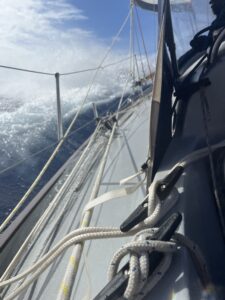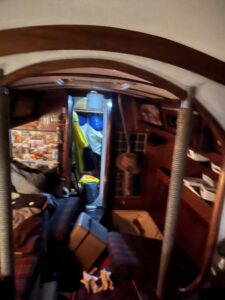
The back of the North Atlantic passage chart has this to say about leaving the UK for the Canaries: “September is a good month”.
Last time I did this trip, I Ieft on September 10th, got there in 13 days and spent most of the time rolling south at six knots under twin headsails with the Portuguese Trades blowing as steadily as they did for the Cutty Sark.
October, says the chart, is “acceptable, but get a good weather report.”
I left on October 4th. I had a good weather report – at least the Windy app offered me moderate north westerlies for 48 hours to get me halfway across Biscay. If I left it for a couple more days, however, there was no end to the prospect of south westerlies, some of them in orange…
Actually, I did consider waiting a couple of days because – would you believe it after the Great Refit – at the last minute I broke a stanchion coming up to the fuel berth in Falmouth.
Anchoring off Trefusis Point, I considered a delay to get a new one. There was one at half price on eBay. I could have it by Thursday.
But by Thursday, the south westerlies would have arrived – and I had 24 days to get to Gran Canaria, check in for my stupid Brexit visa and get to Pasito Blanco in time for the Ocean Cruising Club party.
I ordered a new pair (I think I need a spare) to be sent to Agustin the OCC Port Officer for the Canaries. “Was that all right,” I emailed him. “Of course,” he replied by return. Agustin is great.
So, I left on what I imagined would be a straight-forward 1,400-mile passage. “Two or three weeks,” I told Tamsin.
It was going to be three. It just seemed longer.
For a start there were the calms off Finisterre. Days of calms. Calms and headwinds. In desperation I even motored for 20 hours in the hope of finding some wind. I had screenshots of a week of Windy forecasts, and they suggested that if I were to get further into Biscay, there might be enough wind at least to keep me moving.
Motoring is not something I like to do on long passages – what difference is it going to make over a thousand miles? But I was pleasantly surprised to see how far I could get with the little Nanni 21hp ticking over at 1750 revs.
All the same, when I got to where Windy said there was wind, there wasn’t.
In the end it was the new super zero that got me out of there. This is the enormous lightweight sail set on its own Dyneema luff rope from a short bowsprit and sheeted back to the spinnaker blocks. It is essentially an upwind sail, and the idea is that the merest puff gets the boat moving and generates enough apparent wind to keep her moving. It works.
At least it worked until I put a hole in the leach trying to furl it when it was caught on the crosstree which – I then discovered – had lost its smooth protective boot.
I almost wept with disappointment, shame and frustration. The worst part would be having to tell Paul Lees at Crusader sails what I had done to his beautiful creation.
So, it was fully nine days into the passage before I saw any real progress down the Iberian coast. Of course, I could have cut the corner – abandoned my waypoint 100 miles off Cape Finisterre but, if there is one thing that frightens me as much as lightning at sea, it is the prospect of meeting the marauding Orcas.
I know that people say Orca attacks are statistically very rare and they only want to play but Samsara doesn’t carry hull insurance and I manage to break quite enough stuff without any help from “playful” marine mammals.
Incidentally, here’s a politically incorrect observation: If they’re so bored, can’t they go and learn to do tricks in a nice Disneyland marine park?
(Now, of course, I’m going to be in real trouble. They’re intelligent enough to read this.)
Anyway, I moved the waypoint (it was an exclamation mark) from 100 miles off Finisterre to 50. Apparently, the advice for yachts sailing down the coast is to stay 20 miles offshore, so I should be well out of the way.
Certainly, I was out of the way. I still found myself 100 miles offshore – tacking against persistent southerlies.
These got stronger the further south we bashed. In an area famed since the 17th century for northerly winds, I spent day after day switching between one reef and two, all the hatches shut, the inside of the boat becoming clammier and clammier as cast-off oilies, wet boots and flying food grew into a sort of putrid compost heap on the floor.
Then, one afternoon off Lisbon, the glass dropped like a stone and the wind speed shot up to between 30 and 36 knots. I considered the sensible thing – heaving to. But that would mean going backwards at two knots and I just couldn’t bear it. Also, the boat seemed to be loving the conditions, crashing along at between five and six knots in clouds of spray. Of course, we were only making one knot towards the Canaries as the Navionics track zig-zagged painfully across the screen – and this went on, would you believe for 36 hours…
Then, after just a 24 respite (there was even some north in the wind) would you believe the same thing happened again – the sudden drop in pressure (but only 28-33 knots this time.)
And that was when I got knocked down – in a Force 7. You don’t expect that (nobody expects a knockdown). I’m not going to describe it here because I’ve written a full explanation in another post.
By the time I got to Las Palmas, quite frankly I’d had enough. Also, I have to organise the repairs – which are beginning to resemble another refit.
I think I’ll take the bus to the party.

After the knockdown
